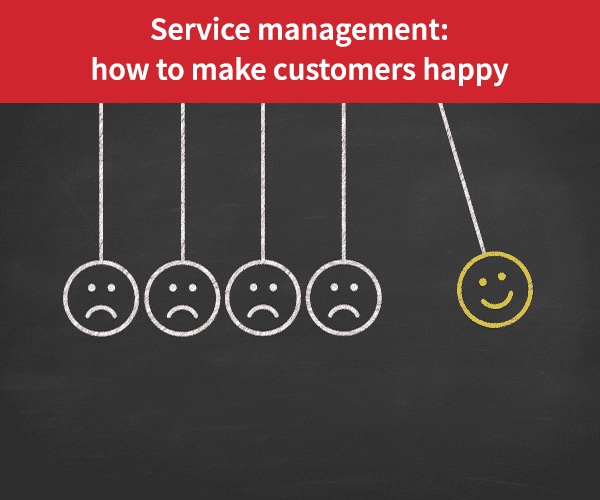
- Field Service Management
- Optimization
- Productivity
- Work orders
6 tips to improve service dispatching
Service companies must put processes in place to monitor their activities over time and ensure compliance with contractual commitments. Here is how to improve the dispatch department.
Monitor field activities in real time
Excellence in business management begins with real-time monitoring of employees’ activities in the field service management system. You need to know whether your technicians are available, on the road, or providing service at any moment. You also need to know whether they’re ahead of, behind, or in sync with their daily schedule.
With a global view of your teams, you can quickly respond when an unforeseen event or emergency arises. By monitoring field activities, you can glean important information, such as the time spent providing service compared to the originally planned time. You can also collect more general information, such as how much time a technician or a team worked in a day, a week, or a month.
To help you gather this information, Praxedo field service management software offers flexible configuration options for activity monitoring. For example, you can create workflows by scripting the sequence of activities. You can then use these workflows to automatically trigger alerts sent to customers so they know service progress. Similarly, field service technician management software allows you to define activities considered “worked” time. This capability ensures you use the best field service management practices to increase efficiency of operations.
Take the right corrective actions
With a dashboard, dispatchers can monitor dispatch management systems’ key performance indicators (KPIs) in real time to turn information into action. The Praxedo field service management software is available with a Cockpit module that offers pre-configured KPIs such as the number of missed appointments, the number of emergency service requests, and the rate at which jobs are being completed, including those that have exceeded the projected job duration. Integrating a field service dispatch app enhances managing and deploying resources effectively and provides insights on how to improve the dispatch department.
React instantly, analyze over time
The dashboard also provides more traditional information such as the number of completed service calls that met the guaranteed restoration time or the guaranteed response time. You can also configure your KPIs. This real-time activity monitoring of field service manager software allows service company managers to respond to problematic situations and offers insights on how to improve dispatch process.
They have the information needed to execute the corrective actions required to maintain quality of service. Dispatchers must also step back and coldly analyze the service company’s activities to improve dispatch efficiency. Based on the service history, how is an agency or field technicians performing? The KPIs used to measure this performance could be: – The number of service calls delivered on the originally scheduled date and at the originally scheduled time – The actual duration of service calls as measured in the field compared to the estimated duration during field service scheduling.
Share KPI and SLA data with customers
These field team management strategies and KPIs allow you to assess the productivity of field teams and to ensure that service level agreement (SLA) commitments, such as the response time, the time required to resolve a problem, or the guaranteed restoration time, are being met. By sharing irrefutable and agreed-upon metrics transparently, service companies can help establish an environment of trust with customers and improve customer experience.
This is very important because the data can be used to apply financial penalties when KPI thresholds are breached. The data can also be fed into daily, weekly, or monthly reports. With this synthesized view, customers can see service performance for a site or a particular type of equipment at a glance, including the rate of completed jobs and those that meet performance guarantees. Moreover, leveraging field team management software enhances the ability to monitor and improve these metrics, further solidifying the effectiveness of field team management strategies.
Give customers proof of your work
Trust is built on evidence. Field service management software must give your field service business customers complete traceability of the service. At the end of the job, technicians take geotagged and timestamped photos of the equipment restored to working order, proving that the service was successful. Attaching these photos to the electronic field service report avoids any risk of litigation. In general, customers must be informed at all stages of service, from when the initial service ticket is created to the end of the job when they electronically sign the electronic field service report. This ensures excellent customer service. FSM software allows you to automate alerts by creating notification scenarios.
Use artificial intelligence and, in the future, blockchain
A field service scheduling optimization engine that uses artificial intelligence field services algorithms helps to ensure all business constraints are considered in schedules. The scheduler inputs all aspects related to contractual commitments into the engine, along with the specifics for the customer account, such as potential service times. The intelligent assistant combines these different data to provide the best possible schedule. Looking ahead, blockchain could also provide valuable capabilities. Blockchain technology allows transactions to be instantly and securely validated with no involvement from trusted third parties. In service management processes, the technology would enable a series of actions — from filing a service ticket to invoicing — to be triggered without human intervention to provide customers with complete traceability.
Equip technicians with a multi-purpose mobile application
However, reality starts in the field, and this traceability is only possible when technicians can collect all the relevant information while moving. The field technician mobile app associated with the field service technician management software must allow field service workers to capture all of the information related to their profession. Technicians use a smartphone, tablet, or laptop to record the time spent providing service, travelling, taking breaks, and other information, ensuring accuracy in scheduling route. Similarly, electronic service reports can be completed using drop-down menus and checkboxes. This data is fed into the dashboard and other reporting tools as well as enterprise resource planning (ERP) and accounting tools so pay slips and invoices can be automatically generated.
Our similar articles.
-
- Customer Satisfaction
- Optimization
- Technician
- Technicien
Field technicians: what you can expect from Generation Y
July 7, 2021 -
- Field Service Management
- Technician
- Field Service Software
- mobile
- user adoption
Empowering Success: Ten Ways to Boost User Adoption for Field Service Management Software
January 24, 2024 -
- Field Service Management
- Customer Satisfaction
- Optimization
- Work orders
How service companies can make customers happy
November 1, 2018


